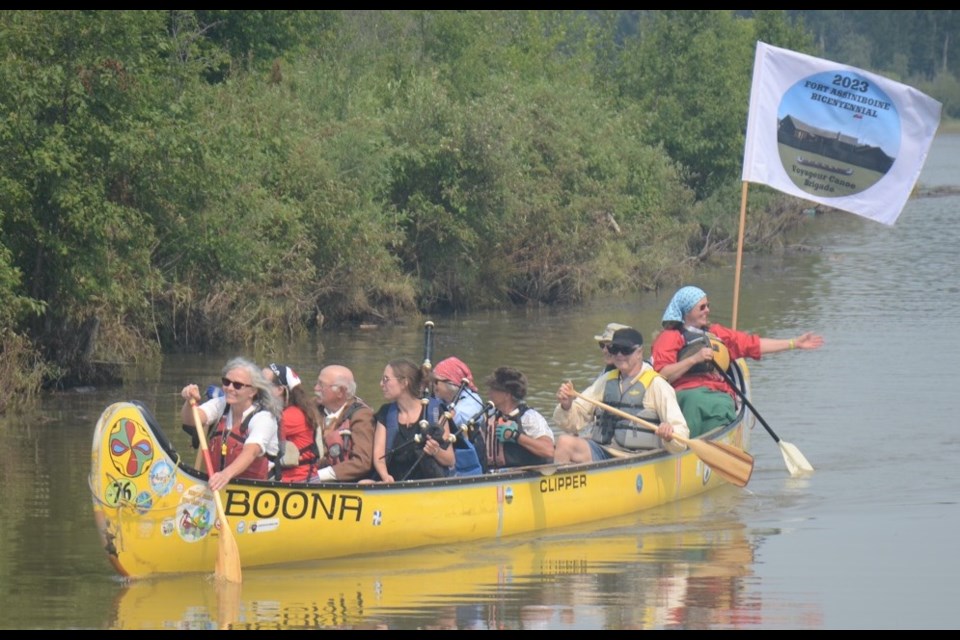FORT ASSINIBOINE — A crowd of hundreds, including many returning families, converged on the small hamlet of Fort Assiniboine for its Bicentennial celebration from Friday to Sunday, July 7-9.
The busiest day by far in terms of visitors was Saturday, as long-time resident and member of the organizing committee Dale Kluin estimated there were around 1,400 people at the free supper inside the hockey arena that evening.
Many of those visitors were families who hadn’t seen each other for 30 to 50 years, Kluin noted, adding, “It was like a big homecoming.”
The celebrations kicked off with a farmer’s market and an axe-throwing demonstration, but the main draw was a “Voices of Legends” show at featuring music of the Beatles and Elvis Presley at the Fort Assiniboine Legion.
The big draw on Saturday was the arrival of the Athabasca River Brigade, a group of paddlers riding in 15 canoes who had set out from Whitecourt July 7.
Back in 2017, the Athabasca River Brigade had made a stop-over in Fort Assiniboine while travelling the Athabasca River to celebrate Canada’s 150th anniversary. This year’s trip was organized specifically to help Fort Assiniboine celebrate its bicentennial.
One of the paddlers was Deb Williams from Courtenay, B.C., who has been participating in the brigade since 2011.
Williams said many of the paddlers hailed from all over Canada, and there were at least three people from the U.S. who come back from every year.
“There’s a sense of camaraderie in brigading that you don’t see in other types of paddling,” she said, noting the experience involves getting to know the communities where they stop a little better.
Williams said there were quite a few young people on the trip this year, which is good because “quite frankly, a lot of us are not young people.”
Prior to the river brigade’s trip, there had been concern that the heavy rains of recent weeks would make the journey unsafe; Williams said some relatives in Edmonton had even urged her to cancel.
She said she was confident that enough time had passed since those rains swept through Alberta to allow for a safe journey. And aside from some rushing water at the start of the journey, the river was mostly calm.
“That certainly was a concern, given the flooding that had happened and the stories that we heard about the number of trees going down,” she said.
“But by the time we (passed), they were just all in piles. It’s been a good, safe journey so far.”
Even so, the number of trees that had been taken out and banks that had been clearly altered by flooding was “quite astonishing,” Williams said.
“Most of us hadn’t paddled this river before, so we don’t know what it would normally look like. But you could see how a lot of the areas had been covered (in flood water).”
Kluin said there were people lined up along the riverbank to see the brigade coming up along the water, eventually coming on shore at the Woodlands RV Park and Marina.
The brigade hung around in Fort Assiniboine July 9 to give visitors short rides along the river, though they departed the following morning. Their journey took them on to the Klondyke Ferry, and Chisholm, and they are expected to arrive in Athabasca this Thursday, July 13.
Saturday’s bicentennial activities also included the aforementioned supper in the hockey arena, which was followed by a concert by the Wild West Fiddlers and two-time Grand North American Old Tyme Fiddle champion Calvin Vollrath.
Kluin said the show lasted until late in the evening and got many people up and dancing.
While there were events like face-painting and farmer’s markets throughout the weekend, many of the bicentennial activities were meant to pay homage to Fort Assiniboine’s history as a former Hudson’s Bay Company trading post established in 1823.
There were also a number of displays set up by First Nations people throughout the hamlet.
One such presenter was Barry Mustus, president of the Whitecourt Isga Tourism Association, who was over by the Fort Assiniboine Museum.
Mustus, who offers Nakota cultural experiences, had set up a teepee and a meat-drying rack; interestingly, both involved the same number of poles, which he said symbolized the moon cycle.
“There’s 13 moons in a year, from one Sundance to the next … and you count the moons to get to the next Sundance,” he said.
Mustus talked about the cultural significance of the teepee’s structure and its building materials, as well as how its building would change with the seasons.
“I've been very busy,” he said. “It was nonstop (on Saturday). People were coming in and out, people were coming in and out."



